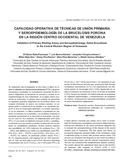| dc.rights.license | http://creativecommons.org/licenses/by-nc-sa/3.0/ve/ | |
| dc.contributor.author | Rubio Fuenmayor, Eli Ramón | |
| dc.contributor.author | Becerra Ramírez, Luís | |
| dc.contributor.author | Trómpiz, Jacqueline | |
| dc.contributor.author | Mejía Silva, William | |
| dc.contributor.author | Pino, Disney | |
| dc.contributor.author | Pérez Barrientos, Mario | |
| dc.contributor.author | Sánchez Villalobos, Alfredo | |
| dc.date.accessioned | 2012-01-13T09:49:19Z | |
| dc.date.available | 2012-01-13T09:49:19Z | |
| dc.date.issued | 2012-01-13T09:49:19Z | |
| dc.identifier.issn | 0798-2259 | es_VE |
| dc.identifier.uri | http://www.saber.ula.ve/handle/123456789/34372 | |
| dc.description.abstract | Se emprendió una investigación en tres fases a objeto de lograr
la validación de fluorescencia polarizada (FPA) y de un inmunoensayo
enzimático de competencia comercial (ELISA-c)
para el diagnóstico de brucelosis en porcinos y evaluar la seroepidemiología
de esta enfermedad en la región centro occidental
de Venezuela. La primera fase consistió en comprobar
la capacidad operativa diagnóstica de las técnicas frente a un
conjunto referencial de sueros con estatus conocido. La segunda
midió la ocurrencia en las granjas y su asociación respecto
al nivel de tecnologías aplicadas y el estatus reproductivo
de los animales. La última consideró la positividad en animales
al momento de su beneficio. Los resultados muestran la
idoneidad operacional en la detección de brucelosis, con puntos
de corte de 78,5 unidades de milipolarización (mP) para
FPA y 21 por ciento de inhibición (%I) para ELISA-c, permitiendo
predecir de modo preciso el estado de infección con un alto
grado de confiabilidad estadística. Ambas técnicas lograron
una sensibilidad del 100% (Intervalo de confianza IC95%: 100
- 100%), pero difirieron en cuanto a la especificidad, para FPA:
95% (IC95%: 85,4 – 100,0%) y para ELISA-c: 65% (IC95%: 44,1
– 85,9%); los valores de predicción positivo fueron 97,6 y
85,1%, respectivamente y del negativo fue del 100% para ambas.
El valor del área bajo la curva ROC (Receiver Operating
Characteristic) fue de 97,7% (IC95%: 92,3-100%) para FPA y de 95,2% (IC95%: 89,7-100%) para ELISA-c. Se demuestra la presencia
de infección por Brucella spp. en porcinos bajo diversas
condiciones reproductivas (4,7%) y en explotaciones con diferentes
grados de tecnologías (6,6 y 3,9%). Igualmente se señala
la ocurrencia de brucelosis a nivel de la sala de beneficio
(7,6%). Se hace un llamado a la implementación de programas
de vigilancia epidemiológica y reestructuración del programa
de control y erradicación de brucelosis permitiendo la inclusión
de estas herramientas diagnósticas. | es_VE |
| dc.language.iso | es | es_VE |
| dc.rights | info:eu-repo/semantics/openAccess | |
| dc.subject | Brucelosis porcina | es_VE |
| dc.subject | Fluorescencia polarizada | es_VE |
| dc.subject | Inmunoensayo enzimático de competencia | es_VE |
| dc.subject | Validación operativa | es_VE |
| dc.title | Capacidad operativa de técnicas de unión primaria y seroepidemiología de la brucelosis porcina en la región centro occidental de Venezuela | es_VE |
| dc.title.alternative | Validation of primary binding assay and seroepidemiology swine brucellosis in the central western region of Venezuela | es_VE |
| dc.type | info:eu-repo/semantics/article | |
| dc.description.abstract1 | A three phase’s research was carried out in order to accomplish
the fluorescence polarization and enzyme-linked immunosorbent
test validations to the swine brucellosis diagnosis and
to evaluate the seroepidemiology of this disease in the central
western area of Venezuela. The first phase was based on
proving the diagnostic operative ability of the techniques, using
a referential group of serum with previous known status. The
second one measured the frequency in the herds according to
the technological levels and the animals’ reproductive status.
The last one considered the slaughterhouse animals’ positivity.
The results showed the operational ideal case in the brucellosis
detection, with cutpoints of 78.5mP (FPA) y 21%I
(ELISA-c), respectively, allowed predicting accurately the infection state with a high coefficient of statistical reliability. Both
techniques got a 100% sensibility (IC95%: 100 - 100%), however
they were different regarding to specificity, for FPA: 95%
(IC95%: 85.4 – 100.0%) and for ELISA-c: 65% (IC95%: 44.1 –
85.9%); the positive prediction values were 97.6 and 85.1%,
respectively; the negative one was 100% for both of them. The
value of the area under the ROC curve was 97.7% (IC95%:
92.3-100%) for FPA and 95.2% (IC95%: 89.7-100%) for
ELISA-c. Considering the above, it is proven the presence of
Brucella spp. infection in swine with different reproductive conditions
(4.7%) as in herds with different technologies levels (6.6
and 3.9%). Moreover, it is pointed out the frequency of brucellosis
at the slaughterhouse level (7.6%). It is asked to implement
epidemiologic survey programs and to restructure the
brucellosis control and eradication program allowing the inclusion
of theses diagnostic tools. | es_VE |
| dc.description.colacion | 500 - 508 | es_VE |
| dc.description.email | saucow33@gmail.com | es_VE |
| dc.description.frecuencia | Bimestral | es_VE |
| dc.identifier.depositolegal | 199102ZU46 | es_VE |
| dc.subject.institucion | Universidad del Zulia (LUZ) | es_VE |
| dc.subject.institucion | Universidad de Los Andes (ULA) | es_VE |
| dc.subject.keywords | Swine brucellosis | es_VE |
| dc.subject.keywords | Operational validation | es_VE |
| dc.subject.publicacionelectronica | Revista Científica | es_VE |
| dc.subject.seccion | Revista Científica: Medicina Veterinaria | es_VE |
| dc.subject.thematiccategory | Medio Ambiente | es_VE |
| dc.subject.tipo | Revistas | es_VE |
| dc.type.media | Texto | es_VE |


